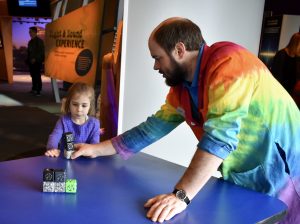Materials to Collect:
- 2 Liter Bottle
- Isopropyl Alcohol
- Bike Pump
- Duct Tape
Try it Out:
- Remove the label from the 2 liter bottle and add 1 teaspoon of Isopropyl Alcohol into the bottle. Allow some time for the alcohol to evaporate inside, a few minutes is enough.
- Place a strip of duct tape across the bottle opening and seal it well by pushing down around the edges.
- Poke a hole into the tape, adjust the hole to the size of your bike pump nozzle. Some pumps come with different nozzles to fill up sports balls or other things. Pick the one that would give you the tightest fit.
- While one person holds the bike pump nozzle tight against the bottle opening, the other should pump air into the bottle. 10 pumps on an average bike pump should be enough (around 20 psi). You will feel the bottle become firm.
- In one swift motion, remove the pump nozzle from the bottle opening. All of the air will rush out, if the pressure in the bottle was high enough a cloud will form. Careful, it will be loud!
What is the Science?:
Isopropyl alcohol evaporates at room temperature and turns into a gas that you can’t see (but you can smell). When the air is pumped into the bottle, it squeezes and compresses the alcohol gas that is floating around and invisible to us while also raising its temperature. When we quickly release the top of the bottle it has the opposite effect, all of that air that we just pumped in rushes out and cools everything down. That cooling turns the alcohol gas back into a liquid with droplets small enough to float in the air: a cloud!
Ask Your Young Scientists:
- What happens when we pump the bottle back up with a cloud still in it?
- What do you feel on the sides of the bottle as it is pumped up?
- Does the cloud stay forever? How long can you make a cloud last?
More to Explore:
Watch for condensation in other places too. Where can we see water changing from an invisible gas back into a liquid? Some great places are the kitchen while cooking, the grass outside in the morning, or the mirror in the bathroom after a shower or bath. Where else can you discover condensation?

Aoife Ryle is a STEM Educator at the Connecticut Science Center. In addition to working with school groups, she works with our Teen Program, Overnights department, and shoots weekly science segments for WFSB. She has a degree in Bioengineering from the University of Maine and has a personal interest in the life sciences and engineering which makes bioengineering a perfect crossover.


